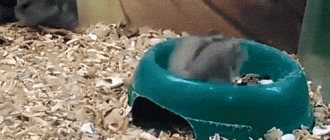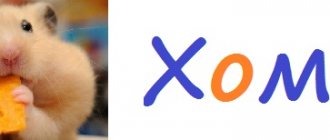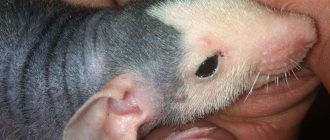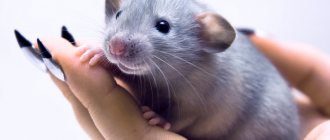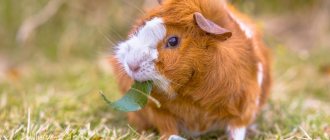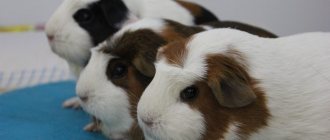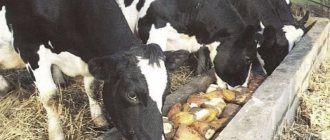07/10/2019 Irina Malinina 0 comments
The Djungarian hamster is a popular animal that can be very often found in modern apartments. This small rodent, belonging to the hamster family, is quite easy to care for. It does not require large material costs and does not require constant attention. At the same time, the funny baby will happily play with the children and amuse them with his antics.
The natural habitat of small rodents is Western Siberia, North-Eastern Kazakhstan, Central and Western Asia.
Djungarian hamster
Djungarian hamsters are easily recognized by a dark longitudinal stripe on the back and a barely noticeable tail. They are not only incredibly cute, but also friendly and unpretentious in their maintenance. Outside the wild, jungarians feel just fine.
Description
The Djungarian hamster (or, as it is often called in common parlance, the Djungarian) is one of the most popular breeds of decorative hamsters. This rodent has a fairly compact size: the body length, as a rule, does not exceed 10 cm. The muzzles of the jungarians are pointed, the cheeks are round and roomy, the ears are small and neat.
In general, these are small, fluffy and funny animals that are very pleasant to watch.
Behavior
Djungarian hamsters are quite friendly and feel great outside the wild. When handled correctly, they easily recognize their owners, react calmly to affection and allow themselves to be taken in hand, and do not hiss or bite.
These pets are active and energetic, but the period of greatest activity occurs in the late evening and night. At this time, rodents like to explore the territory, check their supplies, arrange their homes, spin the wheel, etc.
There are also no problems with the reproduction of dwarfs in captivity. They are incredibly fertile and can produce up to 12 young in one offspring. Babies are born strong, mature quickly and become sexually mature at just 4 weeks of age. However, the optimal age of a female for the first mating is 4 months, because... According to experts, early childbirth has a negative impact on health. The offspring are carried for 18 to 22 days, and within a day after giving birth the female is ready for a new conception.
Taking into account such fertility, be prepared for the fact that if you get two hamsters of different sexes and keep them in the same cage, you will have to place the babies not only among friends, but also among their most distant acquaintances!
Health and life expectancy
Rodents have good health by nature, but Djungarian hamsters have a predisposition to diabetes. To avoid the occurrence of this disease, it is recommended to exclude foods rich in monosaccharides from your pet’s diet.
With proper maintenance, the life expectancy of Djungarian hamsters is on average 3 years.
Features of maintenance and care
Djungarian hamsters are quite unpretentious in maintenance and care. For a happy life, they need a spacious cage (which will always be kept clean), a house, a bedding made of sawdust, a chalk stone so that the furry rodents have the opportunity to grind their teeth, a feeder and a drinking bowl, etc. Also, an active pet will appreciate a running wheel and all sorts of manholes (branches, roots) along which he can travel.
Despite its friendly nature, the Djungarian hamster almost always conflicts with its relatives. At any time of the day or night, he is ready to tirelessly defend his territory and positions. Therefore, so that the life of pets does not turn into one big stress, it is recommended to keep one hamster in one cage.
The basis of the rodents' diet is grains. Hamsters are unpretentious eaters and, as a rule, there are no problems with nutrition. When preparing your pet’s diet, you should strictly follow the recommendations of specialists on suitable nutrition for it. Remember that improper feeding leads to serious illness and death of pets.
Spreading
Djungarian hamsters are common in the southern Siberian steppes of Russia. In the wild, rodents live in burrows and do not hibernate.
Source
Djungarian hamster. Lifestyle and habitat of the Djungarian hamster
The Djungarian hamster is a very cute and popular pet of the hairy-footed hamster species. The beady eyes and soft fur of this little creature leave almost no one indifferent.
In addition, caring for Djungarian hamsters is quite simple and not burdensome. But, before getting a pet, you should still find out more about its life in its natural habitat, so that the little pet’s stay in your home does not become stressful either for him or for you.
The height of the Djungarian hamster usually does not exceed 10 centimeters, and its weight ranges from 35 to 70 grams. Looking at the photo of Djungarian hamsters , you will notice that the tail is so small that it cannot be noticed while the animal is sitting. A narrow strip of dark fur runs along the back, and the species is named hairy-legged due to the hair covering the animal’s feet.
Features and habitat
The habitat of Djungarian hamsters is quite wide. This species is found in the regions of southern Transbaikalia, Tuva, in the Minusinsk, Aginsk and Chui steppes in Altai, in the east of Kazakhstan and in the steppe regions of Western Siberia.
Djungarian hamsters live even in Northeast China and Mongolia. This species prefers to build its home-burrows in desert or steppe landscapes, less often on the outskirts of the forest-steppe.
Sandy, saline, gravelly soils are not scary for the Djungarian hamster. In the Altai region they are found up to an altitude of 3000 meters above sea level. The burrows of Djungarian hamsters are not very branching passages, with a couple of holes and a couple of chambers.
Character and lifestyle of the Djungarian hamster
Djungarian hamsters lead a predominantly crepuscular or nocturnal lifestyle. This type of hamster does not hibernate in winter, but the animal’s fur becomes noticeably lighter when the temperature remains below 16 degrees Celsius for a long time.
Adults prefer to lead a solitary lifestyle. If you want to place a couple of hamsters together, then it is better to take those who have been next to each other since birth. If you try to adopt someone else's hamster, a conflict may arise. However, you can put two hamsters in a cage with a removable partition, and give them time to get used to each other; this way, the partition can be removed over time.
Djungarians are very peaceful, non-aggressive creatures. The domestic Djungarian hamster almost never bites, gets along well with children and easily falls asleep in a person’s arms while being petted.
buy a Djungarian hamster for yourself, or to teach your child responsibility, at almost any pet store. Opinions about where to place this animal vary greatly - some believe that to keep a Djungarian hamster in an aquarium or a glass jar, while others claim that the most suitable place would be a simple metal cage.
But everyone agrees that sand or fine sawdust would be a better bedding. It is also customary to install a small semblance of a house where your pet could hide during the day from bright light, and a wheel or a labyrinth of pipes so that the baby does not get bored, is more mobile and feels better.
Djungarian hamster: features of communication with the animal
The Djungarian hamster, the photo of which is presented below, is a cute and harmless animal. But this little family member also has his own character and behavior. Here's what you need to know when establishing communication with Djungarians:
Relationships with relatives
Djungarian hamsters live alone in nature. If you want to get offspring, then take two rodents from the same litter. Even in this case, they may not get along with each other, and then battles are guaranteed. Dzungariks defend their territory aggressively and assertively, so they fight until there is blood. Keep this in mind if you decide to add a Djungarian or Syrian neighbor to your rodent.
If the female is expecting offspring, move the male to a separate “apartment”. Pregnancy is stressful for both parents, so one of them will definitely eat the offspring.
Photo: pixabay.com: UGC
Djungarian hamster in the same territory with dogs and cats
The presence of a larger predator next to the cage will in no way disrupt the peaceful course of life of the rodent. A smart dwarf will quickly understand that the bars of his cage protect him from the claws and teeth of a cat or dog and will stop paying attention to their attempts to pull him out of the cage. He will also run quickly, rummage through sawdust, and carry grains. Sometimes it will do this on purpose to tease predators.
The danger lies in the hamster's curiosity and energy, which force him to leave the cage at the earliest opportunity. Then his life is in danger. So remember to close the cage, play and train your hamster, making sure there are no other animals in the room.
Communication between a dzhungarik and a person
The smart and funny hamster is easy to tame. He will happily leave the cage to run and frolic in a small space. Rodents react well to children, do not bite, but always try to escape. Since they are fragile and delicate, during play, make sure that the hamster does not get injured by falling from a height or getting stuck between two objects.
Photo: pixabay.com: UGC
To minimize the stress of taming a dwarf:
- In the first week of life in a new place, allow the rodent to adapt. Place the cage so that he can observe people's movements, but so that the noise is minimal.
- Do not disturb the animal during daytime sleep.
- Don't "rob" his bins.
- In the first weeks, watch his games and talk to the animal so that he gets used to the human voice and his presence.
- Lure him out of the house by offering him treats - nuts or dried fruits. After a while he will get used to eating from his hands and sitting on his palm.
Djungarian hamsters are ideal pets for small children. Children 3–4 years old enjoy caring for these animals: feeding them and helping with cleaning. Unpretentiousness and ease of care, lively character and comic actions make the Djungarians family favorites.
Nutrition of the Djungarian hamster
Feeding dzhungarikas is not a burdensome process at all, since these cute creatures are almost omnivores. In the wild, they feed on insects, and towards the end of summer, in Djungarian minks you can already find reserves of a variety of seeds, stored for winter.
So what to feed your Djungarian hamster at home? The choice is very wide; the main type of food remains grain crops, as well as pumpkin or watermelon seeds.
From time to time it is worth diluting the diet with fresh fruits and vegetables so that the hamster can not only eat, but also slightly sharpen its constantly growing teeth (for the same purpose, you can put a small birch block in the place where the hamster is kept).
Even a yolk from a boiled egg and a piece of unsalted lard can be enjoyed by a hamster. But do not overdo it - it is better to divide the hamster's nutrition into two meals a day - morning and evening.
What do dungarian hamsters eat?
Although Djungarians are small hamsters, they love to eat. Moreover, like all steppe rodents, they stock up, dragging the remains of grains and fruits to secluded places in the cage.
Photo: pixabay.com: UGC
Will information about what Djungarians eat help you create a menu for them? The easiest option for owners is to buy a ready-made mixture at a pet store. In it, grains are selected so that the animal’s nutrition is balanced and dietary.
But many representatives of this species are capricious. Therefore, owners will have to take a closer look at what products their pet prefers, and periodically pamper him with such treats.
You need to give your hamster:
- Cereals: oats, corn, barley, peas, seeds.
- Nuts: Greek, peanuts, etc.
- Fresh vegetables: cucumber, carrots, milk corn grains, lettuce.
- Fruits: apple, pear, berries.
- Protein foods: low-fat cottage cheese, a piece of unsalted lard, boiled chicken.
Hamsters are prone to allergies and eczema, so watch their diet. Remove those foods that cause hair loss, flaky skin, and stomach upset.
Foods high in fat (sour cream, hard cheese, cream and butter), smoked meats and any sausages are detrimental to the Djungarian’s delicate stomach. Potatoes, onions, mushrooms, cabbage, citrus fruits, as well as confectionery, honey, sugar and chocolate will cause health problems.
Photo: pixabay.com: UGC
To maintain good physical shape, offer rodents special grain sticks. This fortified food provides dungarians not only with energy, but also with a silky, soft coat, sharp teeth and claws.
To grind down their teeth, they will need a special chalk or mineral stone. Instead, you can offer the animal a birch (in no case coniferous) block.
Reproduction and lifespan
Breeding period of Djungarian hamsters in their natural habitat: from March to September. However, in comfortable conditions when kept at home, they can reproduce all year round.
Hamsters reach sexual maturity at 6 to 8 weeks of age. But at this age you should not rush to have a female with a male - early pregnancy can be dangerous and often ends in the death of the offspring and the female herself.
The ideal age for first mating is 14 weeks. Pregnancy lasts from two to three weeks and leads to the birth of 5 to 8 babies. In a week, newborn dwarfs will have fur, and in a week and a half, their eyes will open.
Three weeks after birth, the offspring are fully viable and should be separated from the mother. Until the time of resettlement, care must be taken to ensure that the mother's diet contains as much protein as possible.
During this period, it is recommended to feed the female with boiled chicken meat, low-fat cottage cheese, and boiled egg yolk. It is strictly forbidden to touch newborn jungarikas in any way; a foreign smell can cause aggression in the mother and encourage her to eat her own offspring. The mother herself is ready for a new fertilization within a day after birth.
With such an incredible speed of development, it is quite natural to ask “ How long do Djungarian hamsters live ?” In fact, the life expectancy of Djungarians does not differ from most other breeds of hamsters, and on average it is only three years. With very good care and maintenance, some individuals of this species live up to four years.
The Djungarian hamster is a wonderful pet for those who want to learn themselves or teach their child responsibility for a living creature. Ideal for becoming the first pet in life - it is not picky about food, does not require special care, has almost no smell, does not bite, does not show aggression and is sold in almost any pet store, but how much joy and pleasure the opportunity to communicate with your family will bring to your family these charming fluffy babies.
Source
How easy is it to care for dzhungarika?
Often a hamster is bought as a gift for a child. This is a wise decision, because the baby will definitely get a positive experience from communicating with his pet, he will learn to take care of someone and be responsible for a living being. A child who has reached the age of 8-9 years can safely be trusted with this matter. But you shouldn’t trust a very tiny baby with a jungarik, he can cripple him or cause aggression in the animal with his childish spontaneity.
Photo: https://pixabay.com/photos/hamster-rodent-pet-2462048/ Keeping and caring for a pet will not create much difficulty. A clean animal maintains its own appearance, it washes itself and cleans its fur with its paws.
Djungarian hamster: description
This species of rodent has an attractive appearance due to its small ears, pointed snout and small black eyes. There is always a darker color on the back than on the belly. The ears and furry feet are often white. A hamster of this species always has a long dark stripe on its back, which makes it different from its other relatives.
Color and length of rodent fur
Domesticated hamsters look different from wild ones thanks to the work of breeders. As a result of breeding work, animals with different types of color were bred. The most common are the following:
Djungarians have short, soft hairs that create a thick, smooth coat.
Length and weight of hamsters
Animals are distinguished by their small size. They reach 10-15 cm. At the same time, the tail can grow up to 1.5-2 cm. The average weight of an adult depends on what gender it is, as well as on the time of year. For males, the norm is 20-45 g, for females - 20-36 g. In winter, the hamster’s weight decreases.
Character of the Djungarian hamster
Despite their apparent friendliness, the Djungarians prefer to live alone. Two individuals in the same cage can come into conflict. As a result of the struggle for territory, they show aggression and cruelty. Animals will be under constant stress, which can lead to a deterioration in their physical condition and subsequent death. Hamsters raised together are more likely to get along with each other, but even then, constant fights can occur between them.
Hamsters quickly get used to people, willingly communicate with them, and go into their arms. These pets are active and curious. Animals love to be petted or talked to in a quiet, gentle voice.
Life expectancy and illness
Djungarians often suffer from injuries they receive during the fall. It is necessary to constantly monitor the condition of the animal’s paws. If the animal is motionless, its limbs are twisted, you need to urgently contact a veterinarian.
Hamsters often suffer from infectious diseases, which reduces their activity and leads to loss of appetite. Sneezing is often observed. It is difficult to cure such diseases, so it is recommended to strengthen your pet’s immunity by giving it vitamins.
With conjunctivitis, the hamster cannot open his eyes, pus accumulates on them. Treatment is carried out by washing. To do this, you should buy saline solution at the pharmacy. The concentration of sodium chloride in it should not exceed 0.9%.
Age-related changes lead to the development of cataracts. Its main symptom is clouding of the pupil. The disease has no cure.
If your hamster refuses to eat, this may indicate problems with the length of its teeth. You cannot reduce them on your own; only a veterinarian can sharpen them. It is better not to allow the teeth to grow, for which purpose a chalk stone should be kept in the cage at all times.
Hamsters can develop allergies. The consequence is often eczema or dermatophytosis. At the same time, the fur becomes faded, begins to fall out, and the skin peels off. At the first signs of illness, the animal should be taken to the veterinarian.
If your pet itches or has red spots on its skin, this may indicate fleas. The medicine is prescribed by a specialist.
Intestinal disorders should also be treated by a veterinarian. Incorrectly prescribed drugs or their overdose will lead to the death of the hamster.
The following information is also important for future owners of Djungarian hamsters: long trips, changes in environment, disruption of the daily routine and the proximity of another animal can lead to stress for the pet, which will weaken its immune system and lead to quick death.
Temperature for keeping hamsters
Ideally 17-20 °C. Air humidity 40 - 70 percent. High humidity negatively affects the heat exchange of living beings. Dry air is also dangerous - if the cage is located less than 2 meters from the battery. As a result, the animal may develop metabolic disorders.
A hygrometer will help keep the situation under control. Think about your pet in advance when ventilating the room so as not to leave him in a draft.
Before getting a hamster, you need to think about its needs in advance. The first thing you need to do is buy a suitable home for your future pet. Many people rely on the opinion of the seller at the pet store, but in vain. After all, the wrong choice not only threatens constant stress for the rodent, but can also lead to injury.
Care and maintenance at home
Proper care and comfortable conditions will ensure that the animal will always be active, friendly and cheerful.
Selecting a cage and filling it
The animal should be provided with sufficient freedom of movement. The cage must be at least 50x30 cm. A small space will lead to low physical activity, which can cause limb failure. You should not choose a high cage, because hamsters love to climb its walls. Falls from heights are very dangerous for a hamster.
Due to the high risk of injury, multi-story cages or complex staircase structures should be avoided.
Sawdust from fruit trees can be used as filler. Needles cannot be used because they cause allergies, lead to breathing problems and death.
You can buy corn litter at the pet store. It is considered the most convenient.
The cage can be filled with undyed paper napkins or towels, which should be torn into small pieces.
For a Djungarian hamster, it is necessary to install a wheel; its diameter should not be less than 16 cm. A small design will lead to curvature of the spine, which can cause limb failure.
You need to put a rest house in the cage. The animal will sleep in it during the day. It is not recommended to use houses with windows, because hamsters often get stuck in them.
Cotton wool, hay, fabric are hazardous materials. They must be kept away from the rodent.
Nutritional Features
Water for the animal is poured into a vacuum or ball drinker. The fluid should be changed daily. Bowls are not placed in the cage, as a wet animal may get sick.
The Djungarian hamster is prone to diabetes. For this reason, you should remove all sweet foods from your diet. The list of unsuitable foods includes carrots, apples, corn, raspberries, peach, pumpkin, etc. Potatoes, baked goods, onions, garlic, and citrus fruits should not be given.
The hamster's diet should consist of dry and wet food. It is recommended to purchase the first one ready-made at a pet store. It is better to use expensive feed, because... they are more balanced.
You can feed the animal with cucumber, lettuce, cauliflower or parsley. All leftover food must be removed immediately. To compensate for the lack of protein, the hamster should be given boiled chicken meat without spices. Outdoor insects should not be offered as they are infested with parasites.
Hamster hygiene
The rodent carries out all hygiene procedures independently. It cleans its body with its paws and tongue. To make the process easier, you can periodically place a container of sand in the cage, which is sold for guinea pigs. Hamsters love to wallow in it for a long time.
You cannot bathe an animal of this species. Water is dangerous for them.
Hamsters fulfill their natural needs in one place, where you can install a toilet for them, which will make cleaning the cage easier.
In winter, dwarfs begin to molt. Their fur becomes lighter. The process lasts 6-8 weeks.
It is important to clean the cage regularly.
Health and prevention
Animals should be protected from loud sounds and screams. Even a little stress can cause the development of diseases.
You cannot place the cage high. Direct sunlight is dangerous for animals, so you should not place your pet on a windowsill or other open place.
If the hamster has become apathetic, refuses to eat, or does not move, you should not expect health to recover on its own, or self-medicate. You must immediately contact a specialist.
Cage for dzhungarika. Basic principles
Think about the size of your home. According to research, the pallet must be at least 50x30 cm. This is the minimum living space, despite the fact that the area of the floors is not taken into account. A small pallet leads to stress, to obesity, it can gnaw on the cell, and therefore live less than expected.
The cage for the dwarf should be low (dunes for rodents are also sold). A small second floor is allowed, but the third floor is clearly superfluous. The hamster may fall and hurt itself. The second floor should not be made of twigs so that the furry's legs do not fall through, otherwise injury is possible. In nature, Djungarian hamsters have long passages in their burrows, so you can buy a cage with a closed labyrinth.
Example of a suitable cell
Some owners place rodents in spacious aquariums - such housing has disadvantages. The main disadvantage is the risk of injury. If there are children in the house, the glass aquarium may break. This will cause injury not only to the hamster, but also to the children. Aquariums are not well ventilated, which results in a bad smell if not cleaned every week.
If you buy a cage secondhand, it must be disinfected and thoroughly washed. The rods are metal (distance no more than 1 cm) and not rusty. Using these tips, you will be able to choose a decent home for your future family member. The next task is to acquire all the hamster's necessities.
Reproduction of Djungarian hamsters
If you place hamsters of different sexes in a cage, they will soon give birth to offspring. In this case, the female must be at least 4 months old, and the male must be at least 3. Gestation continues for 3 weeks. During this period, the female requires a special diet. It should definitely include boiled chicken breast, low-fat cottage cheese and boiled yolk.
During this period, the cage should be cleaned especially carefully, disinfecting all types of surfaces. The products need to be washed off well, because... they can cause allergies.
Newborn Djungarians are characterized by restlessness. But already on the 3-4th day they squeak less. Hamsters are born without hair. The cover begins to form only on the 8-10th day.
After birth, small hamsters are fed with mother's milk for 18-20 weeks. Animals must not be handled. This risks the mother eating her offspring.
Small dwarfs begin to move around the cage independently after 10-12 days. Hearing and vision appear on days 14-16. Hamsters can be separated from their mother after 30-35 days.
Djungarian hamster: description
Djungarian hamsters have a pointed muzzle and small ears. Overall, they are fun and quite attractive pets. Adults, regardless of gender, grow to a maximum length of 10 centimeters and weigh about 70 grams. The back area of the animal is painted in an ocher-gray shade, and the belly area is lighter in color. The digital tubercles are covered with fairly thick hairs.
The inner parts of the ears of the Djungarian hamster, as well as the paws, are white. The peculiarity of the animal is that a thin black stripe runs along the entire ridge of the animal. These rodents are active mainly at night. Hamsters live in burrows that have a nesting chamber, several branches and several entrances.
Interesting moment! Wild individuals are distinguished by the fact that in the summer they have a predominant grayish coat color, and with the onset of winter the coat color lightens and becomes silvery-white.
As for domesticated Djungarian hamsters, they have significant differences in relation to their wild relatives in terms of coat color. Nowadays, domesticated rodents are kept that have very different coat colors. The most popular colors are:
How long do they live?
The disadvantages of keeping such an animal at home include its short life span, which is only 2-3 years. If you create acceptable living conditions, the Djungarian hamster will live a year longer, although this is rather an exception to the rule, but not the norm.
Care and maintenance at home
The natural habitat of Djungarian hamsters extends to semi-fixed sands, as well as gravelly-cinquefoil, wormwood, grass-desert and xerophytic zones of the steppes of North-Eastern Kazakhstan and Central Asia, including the territory of the central regions of Asia, as well as the Western Siberian District.
Therefore, the conditions for keeping this animal in captivity should be as close as possible to natural ones. Maintenance experience shows that Djungarian hamsters, despite the ease of maintenance, still require competent and constant care.
How many jungarians to have?
According to experts, it is permissible to keep only one animal in one cage, regardless of gender. This is due to the fact that these animals are quite territorial and in limited space, capable of showing aggression towards each other.
As a result of keeping several animals in one area, they develop a feeling of permanent stress. In this state, they are capable of inflicting injuries on each other, sometimes incompatible with life. Therefore, each animal purchased for the purpose of further maintenance must be housed in a separate cage.
Selecting a cage and filling it
Keeping Djungarian hamsters at home does not involve any special problems; it is enough to choose the right cage and fill it correctly. The most suitable cage for this small animal may have dimensions of 300x500 mm. A special cage made of transparent plexiglass is also suitable. The pet's cage must contain:
A wide range of similar and other accessories are sold in pet stores. The main thing is that there are enough of them, but not too many. A convenient drinking bowl and feeder must be present in the animal’s cage; a drinking bowl with a volume of about 50 ml is sufficient. It is necessary to ensure that the water in the drinking bowl is changed daily. The feeder should have standard sizes, depending on the size of the animal.
It is important to know! It is not recommended to keep these animals in aquariums with high walls, since the space inside them is poorly ventilated. Therefore, the internal surfaces often fog up, which negatively affects the health of jungarians.
When filling an animal's cage with various accessories, one should not forget about a special stick or mineral stone. They are necessary so that the animal can grind down its teeth. A twig of any fruit tree, with the exception of apricot and cherry, is suitable as a stick.
Care and hygiene
The main feature of caring for a hamster is proper and timely cleaning, which will help prevent the appearance of a persistent and rather unpleasant odor in the home. Cleaning the animal's toilet, including replacing the litter, is carried out at least 1 or 2 times a week. To clean the cage properly, the animal is temporarily transferred to a special container or box.
The most important thing is that the filler should not be removed completely, since a small part of the old filler will help the animal quickly adapt to the conditions after cleaning. This way he will immediately find his toilet, which is very important. Once a month, you should do a thorough cleaning of your pet rodent's cage. In this case, you should not touch the hamster's nest. To wash the bottom of the cage, it is better to use regular laundry soap.
Important to remember! Djungarian hamsters do not need water procedures, since they know how to clean their fur; to do this, they will have to place a special bathing suit with clean, sifted sand in the cage.
It is very important to find the right place for your pet, since animals do not like to be in direct sunlight. They are also negatively affected by drafts and stagnant air. Therefore, the cage should not be located near the TV, refrigerator or computer, and especially not near heating appliances.
What to feed
The most suitable option in this case is to use ready-made commercial food for hamsters. The basis of the diet should be granules and grain mixtures consisting of seeds, grains and pieces of chopped corn. The protein content should be at the level of 15-20 percent. Such granules and mixtures play an important role in the dental hygiene of hamsters. They are also highly concentrated in nutrients. Despite this, they do not represent the only type of food for Djungarian hamsters.
The diet of a domestic rodent, depending on the season, can be expanded to include fruits, vegetables, and herbs. In this case, the expansion of the diet should be carried out gradually, with observation of the animal’s reaction. If diarrhea occurs, which indicates an allergy, it is better to exclude such products from the diet.
Important point! Hamsters should not be allowed to eat raw potatoes, onions, garlic, tomato tops, as well as citrus fruits, watermelons, melons, almonds and chocolate.
Source
Conditions for keeping a hamster
Firstly, a drinking bowl, a feeding trough and a bathing basin . The drinking bowl must be special - with a metal ball. This is the most correct drinking bowl option. Change the water in the drinking bowl daily. The feeder can be made of different materials, but it is better to choose metal or ceramics. The plastic bowl is easy to turn over. You can make a bathing suit yourself using a bowl, the main thing is that it is comfortable to climb into, and that as little sand .
Secondly, you need to buy a house in which he will sleep and spend most of the day. It is important to know that Khomas like to stock up on large amounts of food in their huts, so buy a larger version. Pay attention to the window - it should be large or absent altogether, so that the fluffy does not get stuck in it when it grows up.
Hamster wheel. Is it necessary?
A hamster can run up to 9 kilometers in one night.
Don't forget about the wheel or running disc. This is a kind of cardio exercise machine for hamsters. In pet stores you can find small wheels consisting of rods, the distance between which is 5 mm. You should not buy such a wheel - a dzhungarik hamster can seriously damage its paw while running. The diameter of the wheel should be from 14 centimeters. You can buy a plastic or wooden wheel, but a metal one begins to creak over time.
A walking ball and a Djungarian hamster in it. Good or evil?
If you are concerned about the animals, then do not buy a hamster ball. In the cartoon "Volt" the hamster Rino was in a ball, but do not forget that this is a cartoon. A real animal will not like such a walk, because in a ball the hamster sees objects much worse due to the dull plastic. Poor visibility means it can crash into walls and other objects - no fun.
There is practically no ventilation in the ball, and there is a risk of overheating of the body. Such walks cause considerable stress to the animal, because the hamster actively just wants to get out of the confined space. There are countries planning to ban hamster balls. In Germany, balls are included in the list of animal products with a high risk of injury. So play it safe and keep your furry one in sight while you play.
Litter for rodents
An important point to consider is the filler. Corn filler is better suited, but it is not sold everywhere and is not cheap. As an alternative, use white napkins without dyes or fragrances. Wipes absorb moisture and odors less well, so they require replacement more often. But the hamster will like them, and he will be able to use them to insulate the house.
Corn filler
Is it possible for a dzhungarika to lay newspaper or sawdust as bedding? Newspaper should not be used - printing ink contains lead. Pine or cedar granules, pine sawdust carry a strong allergen for rodents, causing sneezing, rashes and even premature death.
Granular litter for cat litter is also not suitable, even non-coniferous ones. The hamster will simply rub his paws on these huge cobblestones. If you don’t want to spend money, you can wet the napkins (white), squeeze them with your hand into small granules and let them dry completely. Get a kind of analogue of corn filler with your own hands.
Hamster toilet
By nature, hamsters are clean animals: they take care of their fur and “wash themselves” when they wake up, so it’s not difficult to teach a hamster to go to a special toilet.
This hamster skill will allow you to clean the cage not every day, save time and reduce the unpleasant odor. And the Djungarian hamster will walk on dry bedding - which will protect it from colds.
